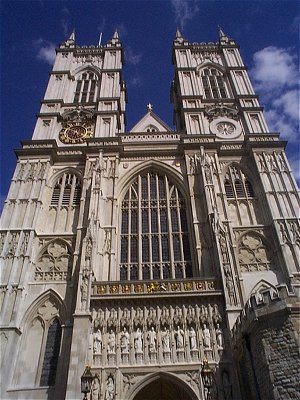
 Westminster Abbey
Westminster Abbey

An architectural masterpiece of the thirteenth to sixteenth centuries,
It has been the setting for every Coronation since 1066 and for numerous other Royal occasions.
Today it is still a church dedicated to regular worship and to the celebration of great events in the life of the nation. Neither a cathedral nor a parish church, Westminster Abbey is a "royal peculiar" under the jurisdiction of a Dean and Chapter, subject only to the Sovereign
Edward the Confessor, the last of the Anglo-Saxon kings ordered the building of the Norman Abbey. Unfortunately, when the Norman abbey was consecrated on 28 December 1065 he was not present, and died a few days later. He was buried behind the High Altar.
Among the most famous ceremonies that occurred in the Norman Abbey were the coronation of William the Conqueror on Christmas day, 1066.
Henry III decided to pull down the Norman Abbey and rebuild it in a new architectural design. Under the decree of the King of England, Westminster Abbey was designed to be not only a great abbey and a place of worship, but also a place for the coronation and burials of monarchs.
Every monarch, since William the Conqueror with the exception of Edward V and Edward VIII was crowned in the Abbey.
Over three thousand people are either buried or memorialised in Westminster Abbey. Notable among these is the Unknown Warrior, whose grave, close to the west door, has become a place of pilgrimage.
Queen Elizabeth I who is buried in one of the chapels, refounded the Abbey as a Collegiate Church, a Royal Peculiar not subject to the rule of any bishop with the Sovereign as Visitor, and laid down its constitution in a charter granted in 1560.
 Coronations have taken place at Westminster Abbey since at least 1066, when William the Conqueror arrived in London after his victory at the Battle of Hastings.
An addition to the abbey was made by Edward I. In 1296, he captured the historic Stone of Scone on which Scottish kings were said to have been crowned for centuries before, and brought it to Westminster Abbey. It was restored to Scotland in 1996.
The Coronation Chair, constructed in 1300-1 with the space for the Stone of Scone beneath the seat.
Coronations have taken place at Westminster Abbey since at least 1066, when William the Conqueror arrived in London after his victory at the Battle of Hastings.
An addition to the abbey was made by Edward I. In 1296, he captured the historic Stone of Scone on which Scottish kings were said to have been crowned for centuries before, and brought it to Westminster Abbey. It was restored to Scotland in 1996.
The Coronation Chair, constructed in 1300-1 with the space for the Stone of Scone beneath the seat.
At the coronation of Queen Elizabeth II in 1953, for the first time the service was televised and millions of her subjects could see and hear the coronation ceremony taking place. It is possible that few watching realized just how far back into history the roots of that magnificent ceremony stretched, and how little fundamental change had occurred over the centuries.
British monarchs buried in Westminster Abbey

 Return to the Fridge door
Return to the Fridge door